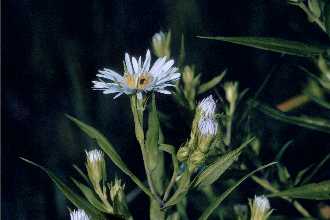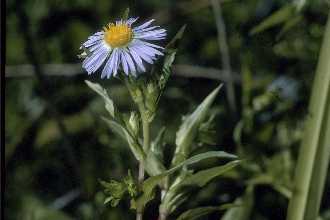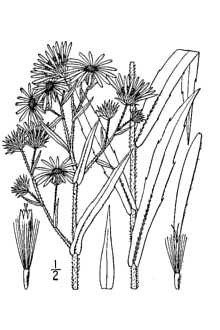Aster puniceus L. var. calderi (B. Boivin) Lepage
Scientific Name: Aster puniceus L. var. calderi (B. Boivin) Lepage
Synonyms: Aster calderi B. Boivin, Aster conduplicatus Burgess, Aster firmus Nees, Aster forwoodii S. Watson, Aster lucidulus (A. Gray) Wiegand, Aster puniceus L., Aster puniceus L. var. <i>calderi</i> (B. Boivin) Lepage, Aster puniceus L. var. <i>calvus</i> Shinners, Aster puniceus L. var. <i>compactus</i> Fernald, Aster puniceus L. var. <i>demissus</i> Lindl., Aster puniceus L. var. <i>firmus</i> (Nees) Torr. & A. Gray, Aster puniceus L. ssp. <i>firmus</i> (Nees) A.G. Jones, Aster puniceus L. var. <i>lucidulus</i> A. Gray, Aster puniceus L. var. <i>oligocephalus</i> Fernald, Aster puniceus L. var. <i>perlongus</i> Fernald, Symphyotrichum firmum (Nees) G.L. Nesom, Symphyotrichum puniceum (L.) Á. Löve & D. Löve var. <i>calderi</i> (B. Boivin) G.L. Nesom
Classification: Plantae/ Tracheobionta / Spermatophyta / Magnoliophyta / Magnoliopsida / Asteridae / Asterales / Asteraceae / Compositae / Symphyotrichum Nees/ Aster puniceus L. var. calderi (B. Boivin) Lepage

| General Information | |
|---|---|
| Usda Symbol | ASPUC2 |
| Group | Dicot |
| Life Cycle | Perennial |
| Growth Habits | Forb/herbSubshrub, |
| Native Locations | ASPUC2 |
Plant Guide
Use a soil moisture meter to monitor the soil moisture where Aster puniceus L. var. calderi (B. Boivin) Lepage is planted.
Plant Traits
Growth Requirements
| Temperature, Minimum (°F) | -35 |
|---|---|
| Adapted to Coarse Textured Soils | No |
| Adapted to Fine Textured Soils | Yes |
| Adapted to Medium Textured Soils | Yes |
| Anaerobic Tolerance | High |
| CaCO3 Tolerance | Low |
| Cold Stratification Required | No |
| Drought Tolerance | Low |
| Fertility Requirement | Medium |
| Fire Tolerance | Medium |
| Frost Free Days, Minimum | 90 |
| Hedge Tolerance | None |
| Moisture Use | High |
| pH, Maximum | 7.5 |
| pH, Minimum | 4.5 |
| Planting Density per Acre, Maxim | 11000 |
| Planting Density per Acre, Minim | 2700 |
| Precipitation, Maximum | 25 |
| Precipitation, Minimum | 17 |
| Root Depth, Minimum (inches) | 10 |
| Salinity Tolerance | None |
| Shade Tolerance | Intolerant |
Morphology/Physiology
| After Harvest Regrowth Rate | Slow |
|---|---|
| Toxicity | None |
| Resprout Ability | No |
| Shape and Orientation | Erect |
| Active Growth Period | Spring, Summer, Fall |
| Bloat | None |
| C:N Ratio | Medium |
| Coppice Potential | No |
| Fall Conspicuous | Yes |
| Fire Resistant | No |
| Flower Color | Blue |
| Flower Conspicuous | Yes |
| Foliage Color | Green |
| Foliage Porosity Summer | Moderate |
| Foliage Porosity Winter | Porous |
| Fruit/Seed Color | Brown |
| Nitrogen Fixation | None |
| Low Growing Grass | No |
| Lifespan | Moderate |
| Leaf Retention | No |
| Known Allelopath | No |
| Height, Mature (feet) | 8.1 |
| Growth Rate | Slow |
| Growth Form | Rhizomatous |
| Fruit/Seed Conspicuous | No |
| Foliage Texture | Medium |
Reproduction
| Vegetative Spread Rate | Slow |
|---|---|
| Small Grain | No |
| Seedling Vigor | Medium |
| Seed Spread Rate | Slow |
| Fruit/Seed Period End | Fall |
| Seed per Pound | 700000 |
| Propagated by Tubers | No |
| Propagated by Sprigs | Yes |
| Propagated by Sod | No |
| Propagated by Seed | Yes |
| Propagated by Corm | No |
| Propagated by Container | No |
| Propagated by Bulb | No |
| Propagated by Bare Root | Yes |
| Fruit/Seed Persistence | No |
| Fruit/Seed Period Begin | Fall |
| Fruit/Seed Abundance | Medium |
| Commercial Availability | Routinely Available |
| Bloom Period | Fall |
| Propagated by Cuttings | No |
Suitability/Use
| Veneer Product | No |
|---|---|
| Pulpwood Product | No |
| Post Product | No |
| Palatable Human | No |
| Palatable Graze Animal | Low |
| Palatable Browse Animal | Low |
| Nursery Stock Product | No |
| Naval Store Product | No |
| Lumber Product | No |
| Fodder Product | No |
| Christmas Tree Product | No |
| Berry/Nut/Seed Product | No |


